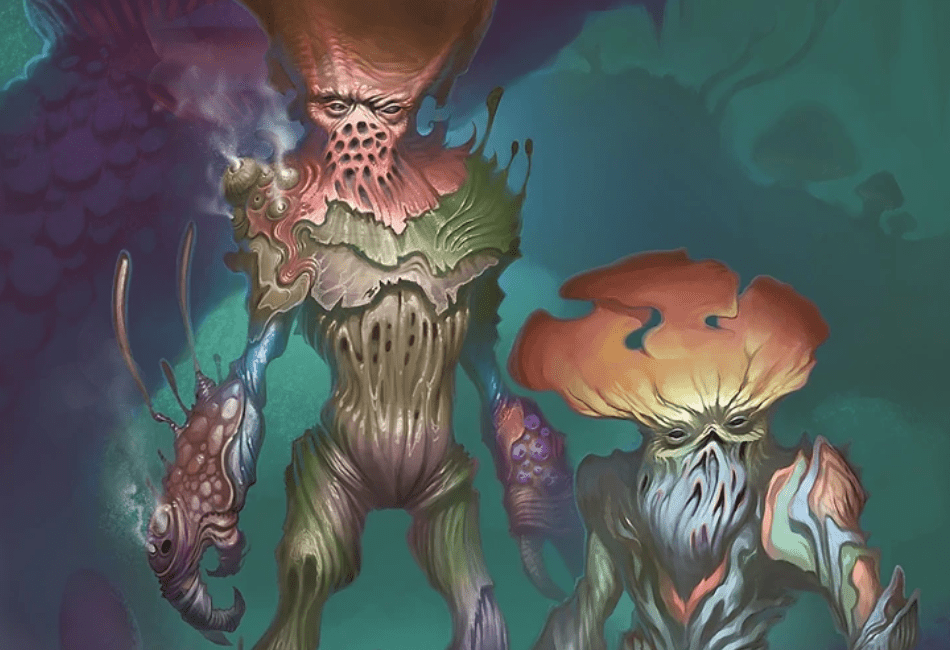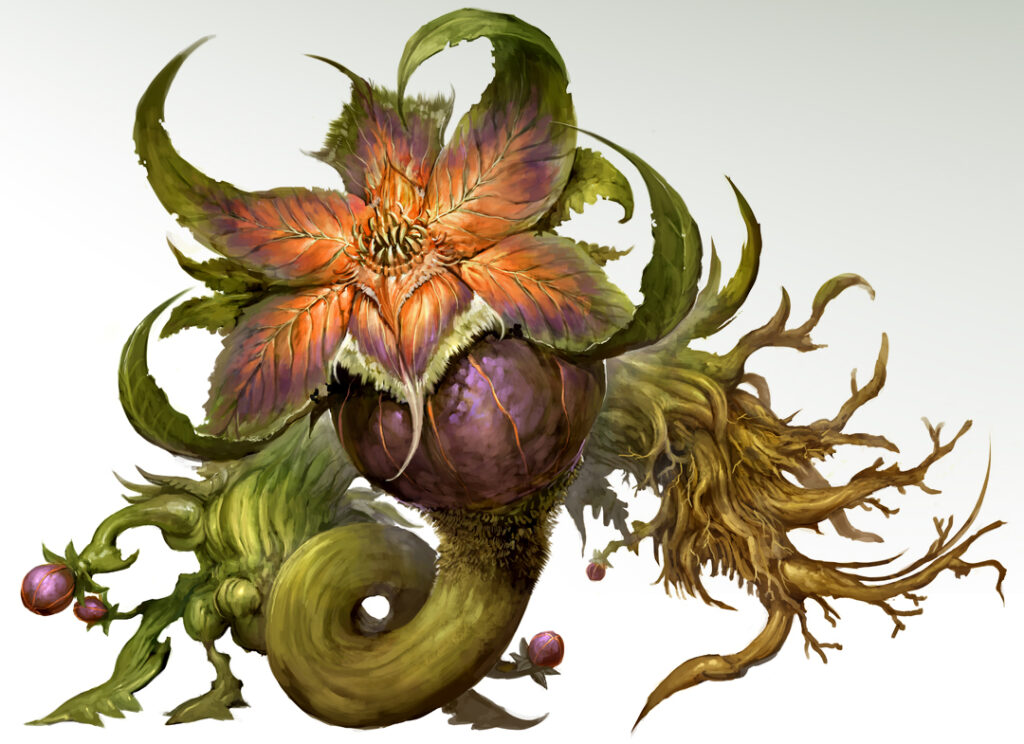Welcome to Boot’s Bountiful Botanical, where I am so crazy that I keep only the most dangerous 5e DnD Plant Monsters. True beauties that would frighten a player and, most importantly, fill a dangerous DM with giggling ideas.
You know — the giggling ideas that make the DM make ‘the face,’ and the party starts clutching their D20s. Be careful, though, even I was surprised by how deadly D&D plants could be. So many of these would be the crutch to my TPK plans if I were a more sinister storyteller.
I’m sorry, player… What’s your Knowledge (Nature) again? Oh, don’t worry about it. Go ahead and pick that flower. Welcome to a Plant Monsters 5e Guide.
Plant Monsters Summarized
A plant monster is, much like a plant, alive yet focused entirely on the drive. While a beast monster may have instincts and emotions such as fear, only a few select plants have evolved the ability to feel any pain, much less brain-matter-oriented troubles such as fear.
Plants hold numerous jobs in the ecosystem, but one of the most overlooked and most important is also the most horrifying. Plants consume the nutrients that rot and decay create to survive. The nutrients of decay, be it through a corpse or waste, will feed the fungus and roots while fertilizing the soil.
This means that a plant has reason to want you dead. It is patient, crafted through nature, and there is nothing to reason with. A plant monster is only hungry, and only the rot of flesh will satisfy that need.
This is as necessary as the lion hunting the deer in the circle of life, and plants are exceptionally good at their job.
On that note, some noted similarities shared between numerous plant monsters;
- Green plants are not as flammable as yellow/dried plants. Consider this before you use pokemon types to attack a plant monster.
- Not all types of tree bark will burn at the same temperature.
- Plant monsters prefer carnivores and often work with them to take on larger prey.
- A plant will usually prefer a rotting carcass to a fresh corpse. Many have the means to speed that process up.
- The deadly thing about plant monsters is, generally, their reproductive cycle.
- Delving into the worldbuilding art of ‘making plant life more animal-like’ is a precarious and dangerous void of forbidden plant knowledge — especially their reproductive cycles.
- Plant monsters make fantastic reagents. Upon defeating a plant monster, the corpse can be dried and sold to a merchant with enough bartering. DM’s discretion.
- Only monsters follow the above advice with Gas Spores.
- Plant Monsters are capable of lying dormant and immobile for long periods. DMs can use multiple types in place of traps to keep players on their toes.
- On that note, never describing plants as a DM and then suddenly finding one mushroom to be of note is incredibly suspicious.
- I have avoided numerous cunning creatures in this guide due to their nature being evolved to the point of alienating the tactics of these creatures listed. Their intelligence score was too high.
- Roses are red, violets are blue, their roots live off rot, and, one day, that will be you.
False Appearance
Most plant monsters that could potentially be seen vibing in a hag’s garden hold the sneaky ability to appear ordinary. While you think their size category means they still might seem peculiar, they instead give the world that DnD whimsy. Tiny fey often finds human-sized mushrooms to be high-quality accommodations after all.
False Appearance will allow a plant monster with this trait to appear like an ordinary plant or fungus if motionless. This means while the players might be able to perceive it until it moves, it might as well be the sister species ‘toughantia luckitus’.
This makes that pleasant park or meandering meadow the potential reason the Honest Tusk Village is experiencing a continued issue with missing villagers.
If the DM is planning to use plant monsters as traps, be sure to casually make a note of plant life in your description of cities and areas. Otherwise, your players will attack that randomly important flower in the dungeon. As some players will opt to just pick the dangerous dungeon flower, this is also a potential play.
Assassin Vines
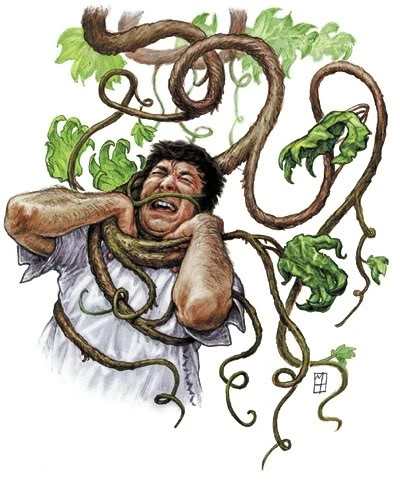
- Book: Ghosts of Saltmarsh
- Challenge Rating: 3
- Typical Terrain: Temperate Forests
- Flora or Fungus? Flora
The Assassin Vine’s distinguishing features are its grape-like berry clusters and the asymmetric five-pointed leaves it grew, which resembled hands. Otherwise, its body is that of a vine bustle. A 20-foot main branch thick as a forearm grows many smaller vines up to 5 feet in length, housing its leaves and fruit.
They are noted as being shockingly resistant to the elements. Burning and Freezing do little to it, while electricity does nothing.
They could move very slowly but be capable of quickly grappling the target like the entangling roots spell. They are also capable of attacking using constrict. 2d6+4 bludgeoning damage is done, and the target is grappled. Until the target escapes, they will take 6d6 poison damage at the start of each of the vine’s turns.
Assassin Vines, even at cr 3, should never be taken lightly. Their constrict can reach 20 feet and grapples on hit. The preceding poison damage doesn’t even have a save. It will just slowly and efficiently end you should you fail to escape.
The grapes of an Assassin Vine grow in the late summer and are considered tough and bitter. However, much like cider apples, they found their place in alcohol, and Assassin Vine Wine is found in many establishments.
Corpse Flower
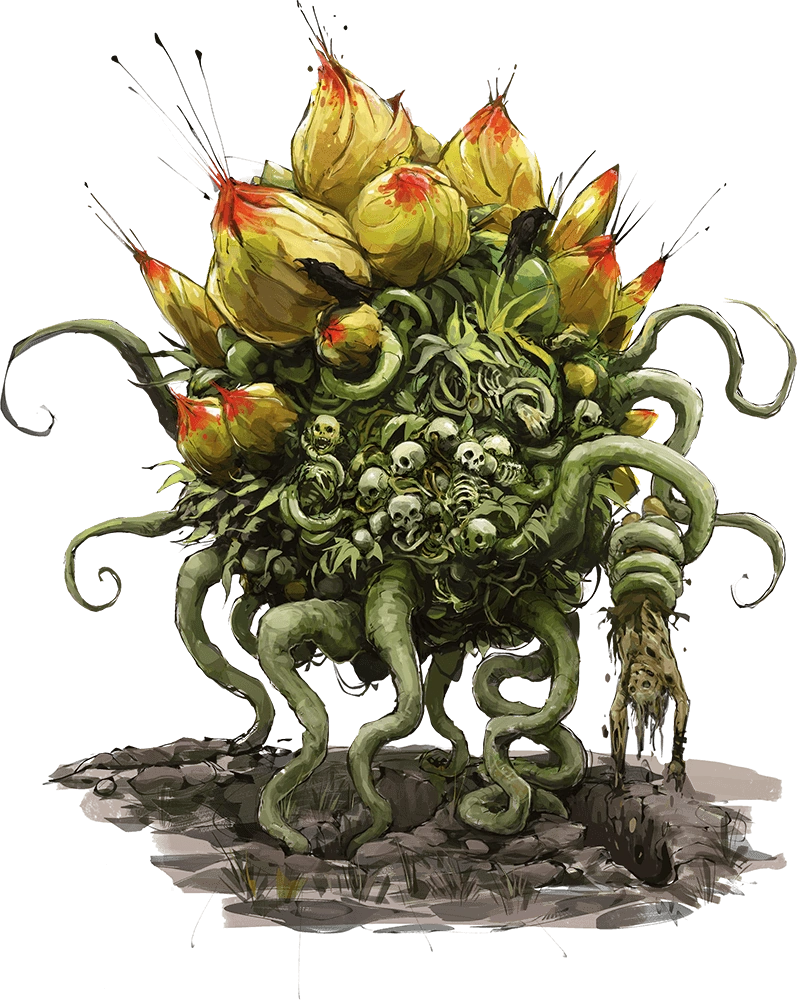
- Book: Mordenkainen’s Tome of Foes
- Challenge Rating: 8
- Typical Terrain: Graveyards and Battlefields
- Flora or Fungus? Flora
Corpse Flowers have a chance of sprouting from the buried remains of a necromancer or a particularly powerful undead. Its center is an entangled mass of skeletal remains, moss, roots, and rot-enriched soil. Next, it moves on many massive root-like tendrils, of which smaller versions sprouted around its center. Finally, from its top, large yellow and orange flowers are enclosed in a bulb.
They can skitter around the battlefield, using these massive tendrils to attack, poison targets, and harvest the dead. Much like its real-world inspiration, a corpse flower smells horrendous. A creature near a corpse flower or its zombies must succeed a dc 14 con save or be incapacitated until the turn’s end.
A corpse flower will contain 1d6+3 corpses which lie a hidden danger. They can only be pulled free if the corpse flower dies. As a bonus action, if it still has these corpses, it can either digest the corpse to instantly regain 2d10 hit points, or it can animate it into a zombie that will act immediately after the corpse flower.
Corpse flowers are a beautiful monster to spice up a necromancer-centered campaign. Should the party have necromancers or undead in their group, Corpse Flowers can act like something they should fear. This is potentially their fate, as it is born from their corpse. Facing a corpse Flower should be to a necromancer or undead as meeting a Psychopomp is to a human.
Gas Spore
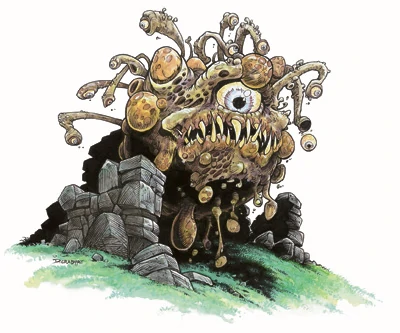
- Book: Monster Manual
- Challenge Rating: 1/2
- Typical Terrain: Cold Hills, Underground, and the Underdark.
- Flora or Fungus? Fungus
Gas Spores have an eerie resemblance to Beholders. Coupled with their preference for dark spaces, can easily be mistaken for one without a dc 15 Int (Nature) check or approaching the gas spore.
This is thanks to how it floats on its own and has a spherical body. This spherical body houses a false eye, and from the top, it grows ten mushrooms that resemble the eyestalks of a beholder. But, unlike a Beholder, it lacks intelligence, and the only paranoid in this cavern is your own.
The Gas Spore is unassuming and, honestly, quite docile. Touching or being touched by the Gas Spore will seemingly do minor damage. However, if a dc 10 con save is failed, the character will take 1d4 damage and become infected with the dangerous disease it carries in its spores.
Letting a gas spore reach zero hit points means it will explode in a Death Burst. If they fail a dc 15 con save, they take 3d6 poison damage and become infected with its disease.
The disease these spores carry invades the system, killing them in 1d12+ infected’s con unless it is removed. Once half that time transpires, they will be considered poisoned until cured or dead. Upon death by these spores, the corpse will sprout 2d4 baby Gas Spores. In seven days, they will be adult gas spores.
A Gas Spore seems inert, but there are two significant ways it can be utilized. First, an assassin can use false claims of a Beholder to lure the party in with the plan of detonating them upon meeting. Then, the players can mistakenly attack the beast, or the assassin can trigger an explosive to destroy the spores.
The second way they can be used is to build the paranoia of a party already dealing with a Beholder. Then, as the Beholder acts through paranoia and deceit, they could quickly start planting these beasts around to herald their coming and take out a bulk of the resistance.
Gas Spores can remind the player that the world of DnD is cruel and crazy, but it has a sense of humor.
Mantrap
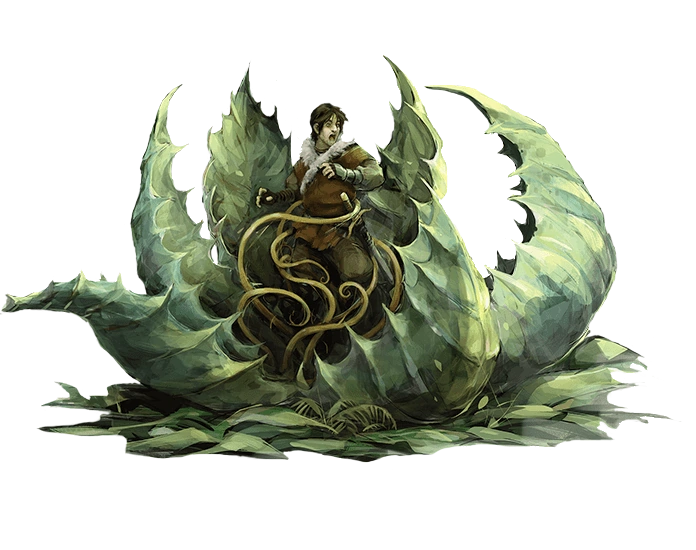
- Book: Tyranny of Dragons & Tomb of Annihilation
- Challenge Rating: 1
- Typical Terrain: Tropical forests and hills
- Flora or Fungus? Flora
This large plant is horrifically deadly and looks like what may have come to your mind, Audrey 2. They are essentially massive venus fly traps. They produce purple blossoms and lack sapience beyond hunger.
During daylight, a Mantrap will continuously release magical pollen within a radius of 30 feet. This pollen’s odor will magically enchant creatures if they fail on a DC 11 Wisdom save. Should they fail, they will be forced to use all their movement to get as close to the mantrap as possible. This will continue for every turn they can not break out of this enchantment, using a new saving roll at the start of their turn.
Once within 5 feet of the mantrap, it will lash out its leafy jaws to Engulf the target. While engulfed, the target is blinded and restrained and has total cover from outside attack.s Problem is that the target also has complete cover from friendly effects. They can attack the creature while inside of it. Should they not be enchanted.
At the start of the target’s turn, until they escape, they will take 4d6 acidic damage until dissolved. Luckily, the mantrap can only engulf one target at a time.
Shambling Mounds

- Book: Monster Manual
- Challenge Rating: 5
- Typical Terrain: Overgrowth. Forests and Jungles.
- Flora or Fungus? Flora
Where the Maneater is Audrey 2, this is Swamp Thing. They vaguely resembled ogres or humanoids in their shape. However, as the name suggests, they were nothing more than Shambling Mounds of vegetation and the rotting matter they consumed.
They function mildly like oozes. First, they seek to pull creatures into this mound of plant matter to allow them to be slowly engulfed and crushed to allow the rotten mater to collect and feed the growing roots and vines. Then, until they die, they just shuffle around, repeating this process while gradually growing bigger with each feast.
This could be a potentially pleasant end, should you come across the variants that were comprised of corrupted blueberries. However, those adventurers who come across the Shambling Mounds that occasionally linger in the sewers of Waterdeep are in for a most unfortunate fate.
While engulfed, the target is blinded, restrained, and unable to breathe. At the start of the mounds turns, engulfed victims must make a DC14 Constitution save or take 2d8+4 bludgeoning damage. In addition, it can only have one target engulfed at a time and move that target around against its will.
Otherwise, its strategy is to make a multi-attack and slam into you for 2d8+4 bludgeoning damage. If both attacks hit the same medium creature, the target is grappled and will have Engulf immediately used on it. Escape dc 14.
That last part is hazardous as it can tip the dominoes into an unplanned TPK-level battle.
A Shambling Mound has massive potential for use in a BBEG’s plans. For example, a Hag or Coven with an Annis Hag could use the Shambling Mound to collect sacrifices. Thus engulfing powerful victims and forcing the Shambling Mound to move them into the ritual, allowing both to be used as sacrifices.
Shrieker
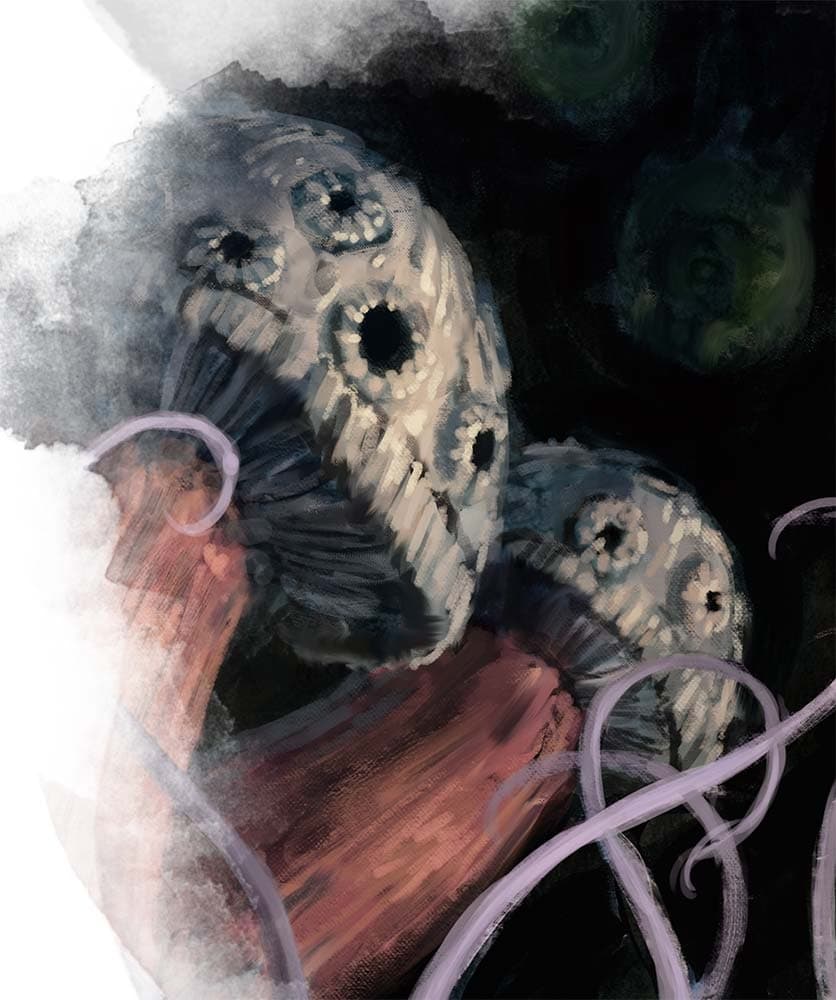
- Book: 5e Monster Manual
- Challenge Rating: 0
- Typical Terrain: Underground, Underdark
- Flora or Fungus? Fungus
The Shrieker might seem harmless and could easily be overlooked by a DM. Still, every dungeon could hose a sneaky security system should shriekers be employed. Furthermore, their 13 (3d8) health makes them a naturally meaty trap to have shrouding key points in dungeons.
They are human-sized, however, so trying to sneakily incorporate them might require hiring a fey to be your interior designer.
When a creature or light comes within 30 feet of the Shrieker, it will begin shrieking, which will be heard within 300 ft. It will continue to do this until the disturbance leaves its personal space. Then, being easily spooked, they will continue to do this for 1d4 turns following this.
Their appearance is indistinguishable from the native fungus, should the Shrieker remain motionless. This makes them excellent for creating an easily missed trap should you remember to pepper unassuming mushrooms into the flavor text as the campaign continues.
Disturbing one will ruin any attempts to leave a dungeon or room unaware.
Tri-Flower Frond
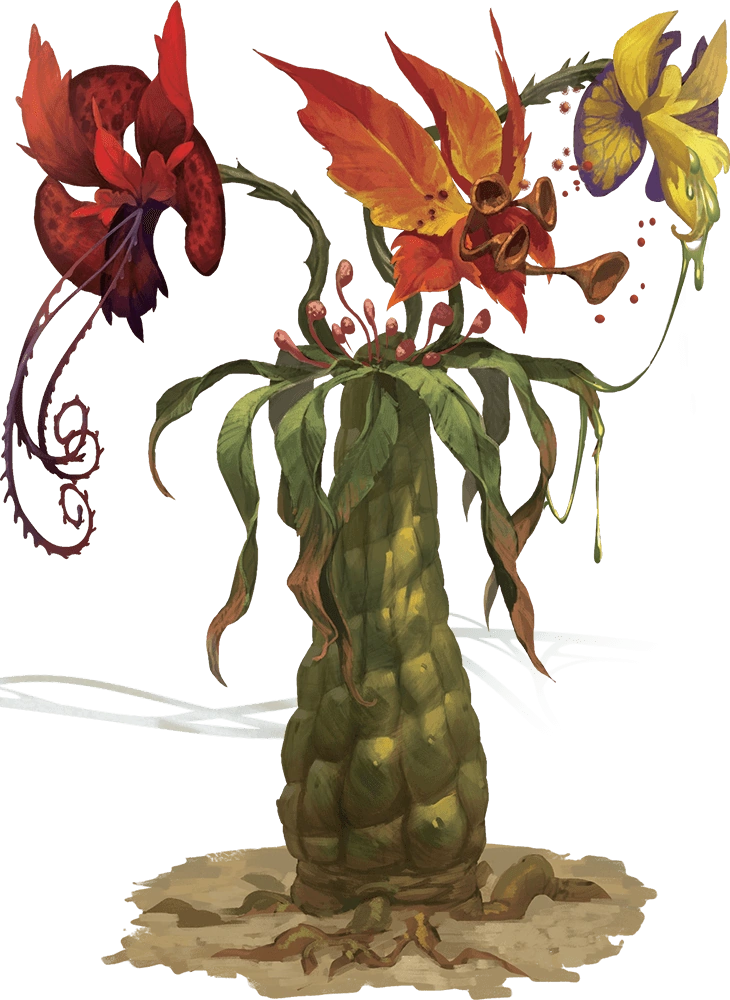
- Book: Tomb of Annihilation
- Challenge Rating: 1/2
- Typical Terrain: Jungle
- Flora or Fungus? Flora
When fully grown, a Tri-Flower frond held a massive stalk at its base. From a crown of leaves and stamen at the top sprout three flowers. One orange, one red, and one yellow. They generally were passive unless a creature drew close. However, they have been known to move when unobserved, sneaking up on camps at night when unaware.
A Tri-Flower Frond will use all three of its flowers in its attack on creatures within five feet.
First, the orange flower will attempt to poison a creature. It must succeed a dc 11 con save or be left unconscious. This poison lasts one hour, with one saving rethrow allowed each minute.
Second, the yellow flower will attempt to cover a creature in a corrosive sap. The creature must succeed in a DC 11 dexterity save or take 5 acid damage at the start of their turn. Water will reduce the damage by one per pint or flask used.
Finally, the red flower will attack. It does 1d4 piercing damage and will grapple the target upon success. Until the creature escapes, it will take 2d4 poison damage at the start of its turn.
Vegepygmies

- Book: Volo’s Guide
- Challenge Rating: 1/4
- Typical Terrain: Warm & Wet dark areas.
- Flora or Fungus? Fungus (Specifically Mold)
Vegepygmies are small humanoid creatures made entirely out of mold-made flesh. They carry the intelligence of society at the beginning of its evolution, but not enough to breach the sound barrier. While Druids may have success communicating with them, they will be found to be more feral than conversive. For a plant, this is still quite the evolutionary feat.
However, being plants, their preference for fresh meat is somewhat unique. They instinctively feel a kinship to other plants. However, they prefer their fungal brethren, such as Shriekers and Violent Fungus.
A rudimentary societal system has formed around their evolution cycle. Your average vegepygmy is only armed with its claws and a sling for ranged attacks. The danger lies in their regenerative abilities and the chief they have deferred to.
As a Vegepygmy age, it will begin to form clusters of spores along its body, signifying its evolution into a ‘chief .’While moderately more intelligent, the less evolved vegepygmies merely cluster and defer to them.
A chief can spread spores of russet mold in a 15-foot cloud around it once per day.
Russet Mold
Russet Mold is the premature form of Vegepygmies. It is a reddish-brown mold that looks like rust if spread across a metal surface. It takes a DC 15 Int(Nature) or Wis(Survival) insight check to be able to tell russet mold apart from rust.
Worse, contact is not needed with the Russet Mold to become infected by it. Spores are released, requiring a DC 13 con save or be poisoned by spores.
If poisoned by Russet Mold, the creature will take 2d6 poison damage at the start of each of their turns, sprouting mold all the while. This effect can be cured by any magic that cures the disease or poison effects.
A beast, giant, or humanoid reduced to 0 hit points by the poison dies and has become a nursery for new veggie pygmies. After 24 hours, several vegepygmies relative to the creature’s size will spawn out of the corpse.
If a beast such as a dog or bear dies to russet mold, it will create the bipedal and thorn-covered variant, a Thorny. A thorny is bestial and often used simply as the attack dogs of the Vegepygmy.
| Small | 1 |
| Medium | 2 |
| Large | 4 |
| Huge | 8 |
| Gargantuan | 16 |
Vegepygmies and their mold can be used by a DM to give an ancient forest ‘untouched by creatures of the flesh’ a whimsical eldritch feel. In addition, their Russet Mold and primitive Ewok leaning behavior (Ewoks are much more intelligent) can give the forest a storied feel without raising questions.
Violet Fungus
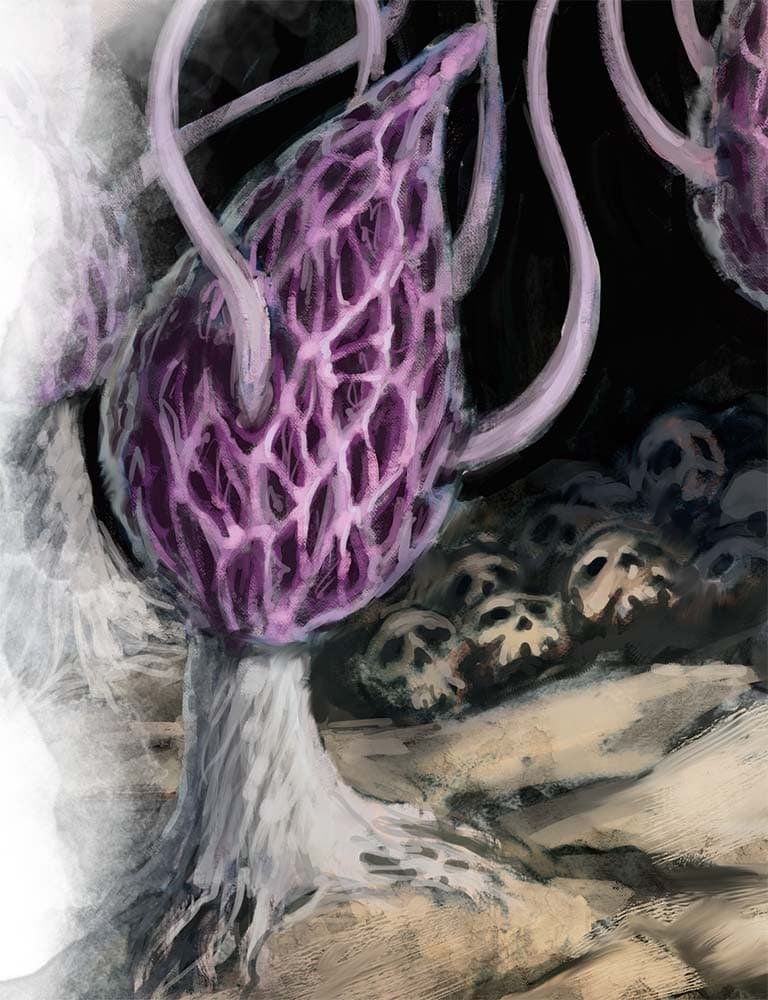
- Book: 5e Monster Manual
- Challenge Rating: ¼
- Typical Terrain: Underground/Underdark
- Flora or Fungus? Fungus
Violet Fungi are human-sized fungi capable of movement using a mass of root-like tendrils. They can range in colors and textures. They don’t even particularly need to be purple. Violet does dance along the visible spectrum of light, after all.
They acted on instinct, if not under the control of a more complex mind, standing motionless in their preferred hunting ground until decay presented itself. Then, upon sensing nearby motion, they will flail their poisonous appendages violently.
The unique danger a Violent Fungus presents is its multi-attack. It makes 1d4 attacks in a round, each inflicting its necrotic poison. This poison will deal 1d8 necrotic damage on a hit. While they have a low CR, they have a shocking amount of damage potential as, being a fungus, you might learn you are surrounded by them.
This unique attack strategy, combined with its unassuming CR and appearance, makes it a risky target that can ruin a party’s day. Should the DM effectively place them.
Wood Woad
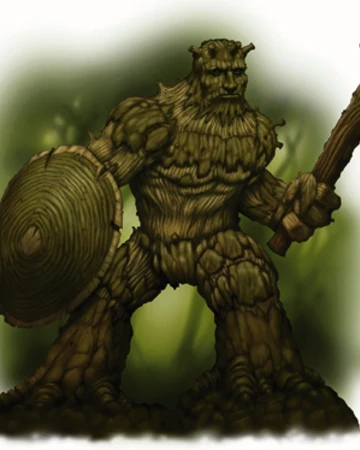
- Book: Volo’s Guide to Monsters
- Challenge Rating: 5
- Typical Terrain: Forests
- Flora or Fungus? Flora
Wood Woads are formed from a twisted act. First, a ritual is performed where the heart of a living humanoid is removed. Then, the corpsed is buried while a seed is planted within the removed heart. This heart would be placed inside the cavity of a tree nearby the buried corpse, and the sacrifice’s blood will be spread over its bark. After three days, wood woad will sprout nearby. Ready for the orders, it will be eternally bound until relieved.
While not necessarily made of the Fey Wylds, wood Woads are often mistaken as such. This is due to their tendency to ally themselves with Druids, Dryads, and Treants once freed from service. In reality, Wood woads are more in line with Magical Constructs.
Wood woad can make two attacks a round with its magical club, which does 4d4+4 damage. Its greatest strengths lay in its communion with nature. It has the advantage of stealth in terrains with obstructive plant life and can ‘Tree Stride,’ which allows it to use a tree within 5 ft of the wood woad to teleport to a tree within 60 feet of the first tree.
Worse, at the start of its turn, it will regenerate 10 hit points if it is in contact with the ground. So long as the land in question has not been burnt in the previous turn. A wood woad only dies if it starts a turn with zero and has no means of regeneration.
This is that thing everyone has been telling you to burn and salt the ground the ashes are on.
All of this creates an excellent minion for your dark ritualists while keeping that air of whimsical forests. Wood Woads, as such, make an amazing ally for Hags as the creature most likely know their twisted ritual. As the Wood woad follows a specific order, a hag can suggest that a Wood woad torment the party. If done with the intent to retreat, it can keep them constantly agitated and exhausted until they find her hut.
Yellow Musk Creeper
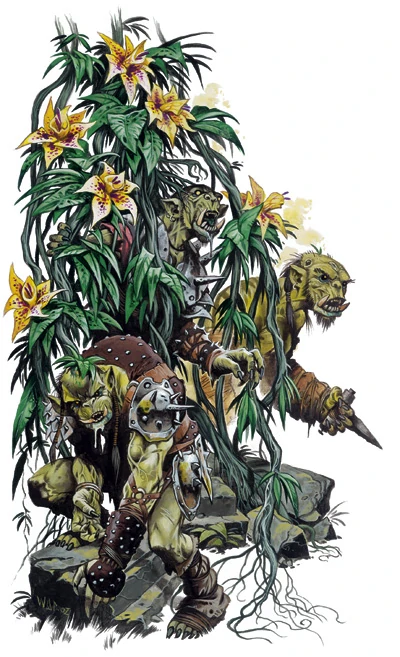
- Book: Tomb of Annihilation
- Challenge Rating: 2
- Typical Terrain: Anywhere
- Flora or Fungus? Flora
The Yellow Musk Creeper resembles climbing vines with large yellow flowers which resemble Orchids. Like Climbing Vines, they would be found climbing up surfaces such as walls or pillars. From here, they remain motionless until it is their time to strike.
Unless the creeper takes fire, necrotic, or radiant damage, it will recover 10 points of damage on its next turn. Unless you remove this regenerating ability, it will continue to do so upon reaching zero.
Nothing about these things is chill. Should a creature fall to 0 as a result of its touch attack, it will implant a plant bulb. If this bulb is not destroyed, the corpse it is in will transform into a yellow musk zombie. The bulb will be destroyed if the corpse is reanimated or a remove curse is placed on it before reanimation.
Worse, it can release a strong musk in a 30-foot radius three times a day. Should a creature fail a dc 11 wisdom throw, it will be charmed by the creeper for one minute. Until the creature can escape this charm, it will do nothing but attempt to get closer to the creeper.
Plant FAQ
Question: How can I implement Plant Monsters into my DnD 5e campaign?
Answer: A player’s paranoia is as good as their DM’s cunning. I have known very few players investigate the plants where they set up camp should there be nothing inherently suspicious about them. So should you be looking to exhaust the players in the world through a cruel gauntlet, start peppering your clearing description with red herrings, then sneak assassin vines in.
Question: What creative uses can a player use Plant Monster harvest for?
Answer: Where your arguments with your DM on what you can do with the various plant kingdoms are based entirely on either party’s botany knowledge, there are a couple of fun plot angles that could be had. Many poisonous plants have nonpoisonous parts that are widely used today for food and medicine.
A player can also use things such as the berries of an assassin vine for diplomacy. Thanks to how dangerous these plants are to a common NPC, the danger required to obtain these materials alone is worthy of haggling with the local alchemist.
Question: Wouldn’t using plant monsters make me, a DM, some Dryad-chasing elf?
Answer: Get out of my botanical garden. Serious answer, no! The beauty of plant monsters is that gray area in a narrative where flowers often denote safety, purity, and splendor. In DnD it might physically strangle you and use your corpse to feed the native tribe of Vegepygmies.
With the same lack of empathy, a bramble bush will use a flower to lure a sheep, have its thorns capture its wool, and then patiently wait until it starves.
Conclusion
Your adventures fighting fey, gambling with goblins, and manipulating Mindflayers might have made you think the only place to find any sanctuary is around a campfire in a nice flower-filled forest clearing.
The stars are peaceful overhead. A field of grapevines growing purple flowers to your left peacefully sways in the moonlight. To your camp’s right, a field full of yellow, red, and orange flowers which, under the breeze blowing through the forest, give their unique growth pattern the illusion of glittering gold or a forge’s fire.
What’s the pattern? Orange, red, yellow, repeat. Roll an insight check…5? You think the person who planted these must have been insanely dedicated.
You wake up in the middle of the night, entangled by vines. Vegepygmies are advancing with spears, and your camp is surrounded by towering Tri-Frond Flowers and bound by Assassin Vines.
You are exhausted, and you have a disadvantage.
Roll for initiative.
- Blight 5e Guide: Blood-Thirsty Brambles - August 28, 2022
- Constructs 5e Guide: Intimidating Innovation - August 20, 2022
- Modrons 5e Guide - August 13, 2022

